Once a PR professional learns what AVE means, a bigger question quickly arises: is AVE an accurate metric? In this article, we’ll guide you through using AVE, address any frequent questions, and explore AVE alternatives.
What we do know for sure is that PRs use AVE because their clients ask to see it. But we’ll point out that more accurate metrics can be used for your PR measurements.
We’ll even dive a little deeper and answer:
- ’What does AVE mean today?’
- ‘What is AVE in PR?’
- 'Is ad value equivalency the best way to measure a PR mention’s worth?’
Catch up on PR Episodes 2024 to learn more about more effective PR measurement. Gain practical insights on showing the impact of your efforts while avoiding the pitfalls of outdated and inefficient metrics.
Table of contents
- What is Advertising Value Equivalency (AVE)?
- How to calculate AVE?
- Why AVE doesn’t work for modern PR
- Five reasons to stop using AVE to measure earned media coverage in 2023
- Why is AVE still used in public relations?
- What are the alternatives to AVE?
- How to measure your PR impact on your business and target groups
- Conclusions
If you’re looking for a tool to track PR metrics that matter, try Prowly’s Media Monitoring with the 7-day free trial.
Start tracking media tiers, share of voice, and top mentions immediately and see if the tool fits your needs.
What is Advertising Value Equivalency (AVE)?
Let’s first define AVE.
Advertising Value Equivalency (AVE) is a simple calculation that estimates the value of a PR mention by comparing it to the cost of a comparable advertisement.
For example, if your PR campaign resulted in a quarter-page article in a printed magazine, you would value the PR mention as the same cost of that ad space.
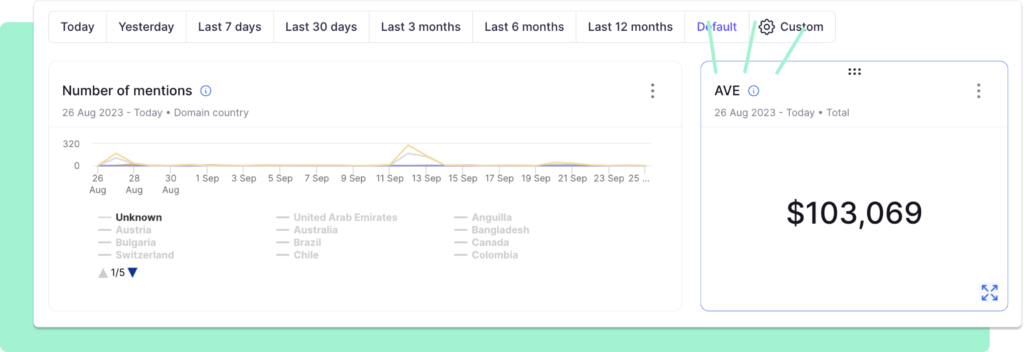
But here is the problem: the dated AVE PR metric no longer works for modern PR. The PR industry developed it as a measurement tool in the 1940s(!) and no longer fully reflects today’s digital landscape.
Despite this, it can still provide a very general “back of the napkin” calculation to start valuing your press mentions, so let’s look at how you create an AVE.
How to calculate AVE?
So, how is advertising value equivalency (AVE) calculated?
In its most simple calculation, it’s article size x ad rate. You can see where this AVE concept emerged: from traditional newspaper advertising!
The AVE definition originally meant an article’s value was its size (a column inch of coverage) x the ad rate (the media outlet’s rate per inch).
To illustrate: a 15-inch column x $100 per inch ad rate = $1500 AVE.
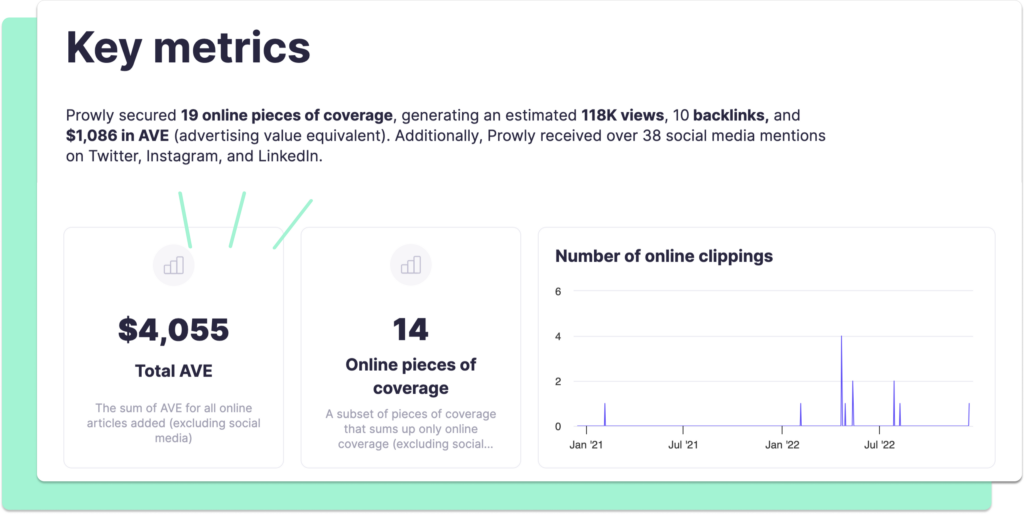
Over time, however, PRs adjusted this basic advertising value equivalency formula because we all know a news article holds more weight than paid advertisement.
Think about it: a news article is written by a third party, showing more credibility than an ad message written by the company.
With this in mind, PR pros began multiplying the AVE value by 2x-12x based on their estimates of how much more value should be included. They also added factors to account for a total reach calculation. In their hunt for the true meaning of AVE, they diluted the formula into hypotheticals.
Today, there is no need to calculate this manually. Keep it simple and let Prowly calculate your best PR metrics - as shown in the exemplary report above.
Advertising Value Equivalency Calculator in PR tools
As you can see, it’s one thing to know the definition of AVE and another to successfully use advertising value equivalency to give your clients an accurate PR value metric.
But here’s the good news: PR media monitoring tools will calculate your AVE. They are even more successful in calculating reach, audience, and sentiment.
Let’s look at the example of how you can do it in Prowly:
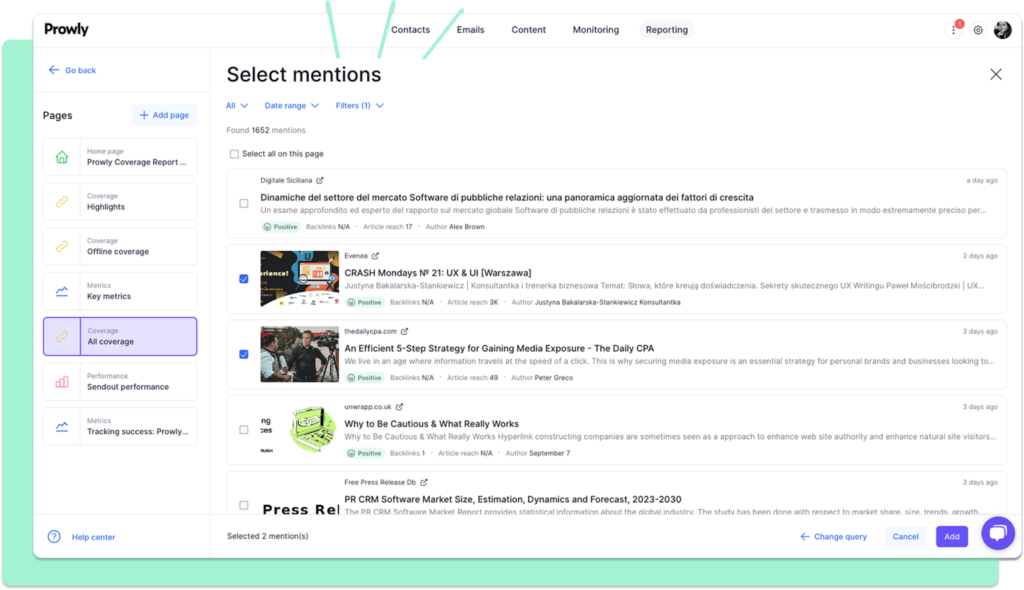
- Add press mentions directly into a client report without copying and pasting links (thanks to the integration of software's PR reports and media monitoring tools). 🔗
- You, your team, and the clients can then automatically view the coverage in one place with all the screenshots and statistics, like domain rank, sentiment, and AVE.
You can find both AVE and its alternatives in Prowly.
If you want to start measuring meaningful PR metrics right away, here's a complete Media Mentions guide and a 7-day free trial from Prowly.
Why AVE doesn’t work for modern PR
Clients have asked PR pros to show the value of earned media from the onset of the industry. So, calculating earned media value was an early issue that had to be tackled.
What did PR pros do?
They borrowed metrics from the advertising industry and then felt pressure to use them for decades because they were competing against big numbers from the sales and marketing teams.
This means that, quite frankly, the AVE measurement is a true relic of the past.
Is AVE an accurate metric?
Not really.
📛 It bases the value of a well-executed public relations campaign against a benchmark outside of its power: advertising costs.
Many PR agencies have turned away from AVE altogether. In 2017, for example, many PR organizations, including AMEC and CIPR, banned using AVE as a valid metric. But many other agencies still haven’t found a good replacement, though.
Our recent AI and tech report found that AVE still lingers in many PR reports, although there are signs that advanced tech is beginning to take the lead. Only 20.6% of the surveyed chose AVE as one of the metrics to consider when
measuring the success of a PR campaign.
One other ad equivalency value measurement that has gained a lot of traction in the meantime (and is also a so-called "vanity metric") is Unique Visitors Per Month (UVPM). This has come into play as most press mentions now take place online.
Five reasons to stop using AVE in 2023
Metrics like AVE can look big and impressive but are not meaningful for assessing a PR strategy. Here are 5 ways AVE is no longer “measuring up” for PR.
#1 AVE underestimates the real value
As we mentioned, it doesn’t show the credibility of an article written by a journalist. A new article is more respected than a paid advertisement and is much more likely to be read and thoughtfully considered.
#2 AVE lacks standardization
Every PR platform generates the AVE formula slightly differently. This makes the measurement difficult to rely on.
#3 AVE fails to provide qualitative data
AVE says nothing about the quality of the mention and doesn’t accurately measure if a brand reached its target audience, engaged the article’s readers, or delivered key messages.
#4 AVE doesn’t provide sentiment
AVE may seem impressive until the sentiment is checked. That’s because a brewing PR crisis can generate a spike in mentions and (or better than) a positive piece of news coverage.
#5 AVE sets unreachable goals for PR pros
Media outlets may fluctuate their ad rates based on market factors and declining subscriptions, and these declining ad space rates unnaturally reduce PR value.
You can track AVE and its alternatives in Prowly's Media Monitoring, which is seamlessly connected to the PR Reports tool to make your campaign evaluation quicker.
Why is AVE still used in Public Relations?
Most likely, because AVE remains a simple way to calculate the estimated value for an ad, and with clients insisting on reported value, PRs may find themselves relying on AVE more than they’d like to.
Do any of these reasons sound familiar?
- The C-suite understands advertising better than PR, so they like to see advertising metrics in reported value.
- Clients telling you they need some sort of number to show their boss so they can continue funding their PR efforts.
- Almost always, the AVE number is a lot bigger than the cost of a campaign, meaning it’s an easy way to justify a PR investment and impress a client.
- "It’s just easier to calculate AVE and be done with it!"
What are the alternatives to AVE? Meaningful PR metrics
If AVE has no clear successor, you must be left wondering about the alternatives.
In general, shooting for metrics showing quality over quantity is recommended. The numbers may not be as big, but they will be more meaningful.
How to find the best metrics for your campaign?
Start with these 3 questions:
- Are you published in a media outlet where your target audience is present?
- Are you improving your brand visibility through this press mention?
- Are you improving your SEO through this press mention?
Then, drill down into the following PR metric alternatives.
💡 Be where your target audience is: Media tiers
Track the number of media tiers you have captured. Each media tier has value based on reach and reputation. A mix of media tiers is common and demonstrates you reached a wide range of audiences.
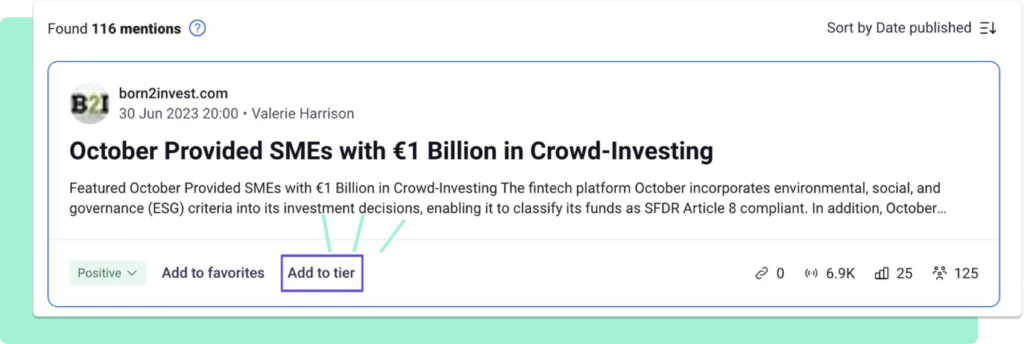
💡 Be where your target group is: Top mentions
Look at your top mentions and drill down into sentiment. Was it positive? Did the media mention accurately deliver your campaign’s key messages?
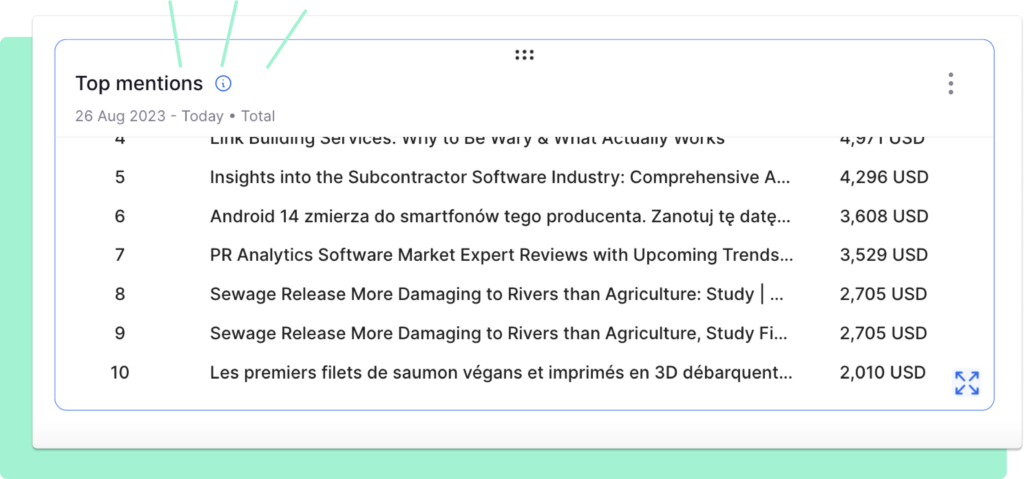
💡 Improve your brand visibility: Share of Voice (SOV)
Use media monitoring tools to measure Share of Voice and show how your brand is performing against your competitors. Prowly’s automated PR software is one place where you can gather this valuable information.
💡 Measure the emotional impact: Sentiment analysis
Many PRs are beginning to rely more and more on sentiment analysis, as it addresses the qualitative value of press mentions. You wouldn’t value a negative press mention the same way you would a positive one!

Again, this is where a media monitoring tool will get you the best information.
These tools use algorithms and machine learning to extract sentiment analysis from your mentions. In Prowly’s tool, sentiment is then grouped into easy-to-follow types.
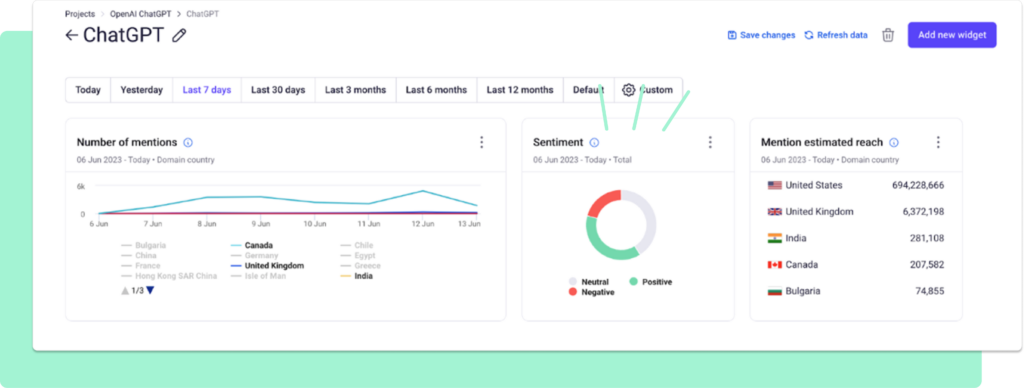
Pro tip: With Prowly, you can personalize your data visualization. You can export the data to Excel (.XLSX) or Numbers (.CSV) or copy it to a PR report to easily share your outcomes with your clients.
💡 Improve SEO in PR: Check domain authority
Domain authority is a machine-learning-based score of the press mention domain. It’s measured on a scale from 0 to 100; the higher the score, the stronger the domain authority. The score (calculated by Semrush) reflects a web page's overall quality and SEO performance.
💡 Improve SEO in PR: Track backlinks
One of the best outcomes of a media mention is the backlinks it produces. This valuable PR measurement should not be overlooked, especially when accounting for the time most people now spend online.
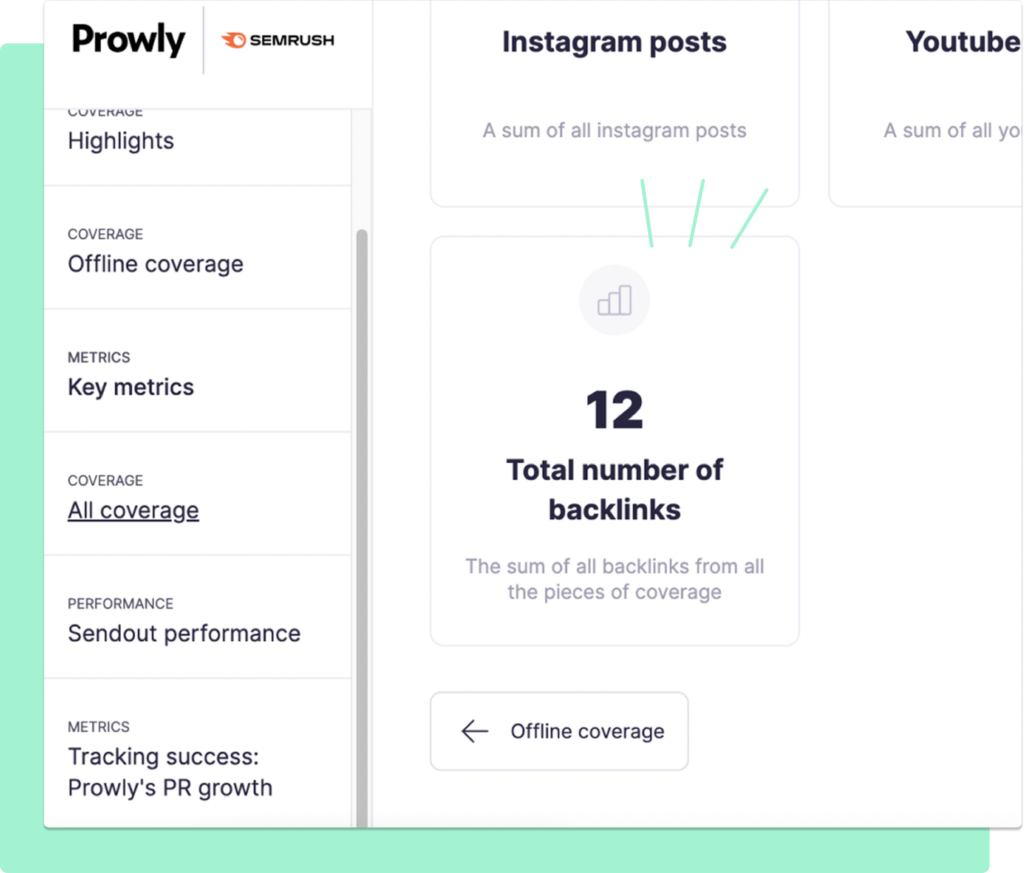
Use a PR software tool like Prowly to track backlinks to get credit for this benefit. For your convenience, they are counted automatically and displayed on the project's main media monitoring dashboard.
Prowly can measure AVE and other metrics for you automatically, so you can focus on other important tasks.
How to measure your PR impact on business and target groups
→ How does PR impact business?
This is never an easy measurement to calculate, but you can make strong assessments by looking at all of the metrics we’ve mentioned here, plus website metrics from Google Analytics and supporting sales referral data from CRMs.
- Create a timeline that illustrates the correlation between your PR campaign and business results, typically using a line chart to present the outcomes of your campaigns against a timeline of business data.
- Show how KPIs like website traffic, brand keyword search, leads, webinar signups, and app downloads changed over time.
→ How do you impact your target audience?
This requires a little extra effort but is a worthy exercise: pick the top five tier 1 press mentions and create a custom metric that will help you assign value to how well you believe the article communicated your key messages to your target audience.
Conclusions
AVE is undoubtedly dated and should be used sparingly to focus on more reliable qualitative measurements that now exist.
That being said, we know many of you will continue to be asked to provide AVEs for your clients, so you can count on PR tools like Prowly to make that an easy measurement to get your hands on.
Start a free 7-day trial with Prowly and look more closely at your PR metrics.

